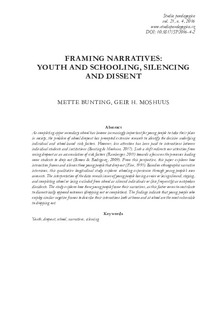| dc.contributor.author | Bunting, Mette | |
| dc.contributor.author | Moshuus, Geir H. | |
| dc.date.accessioned | 2018-02-22T13:31:58Z | |
| dc.date.available | 2018-02-22T13:31:58Z | |
| dc.date.created | 2017-03-13T10:39:27Z | |
| dc.date.issued | 2016 | |
| dc.identifier.citation | Studia Paedagogica. 2016, 21 (4), 35-52. | nb_NO |
| dc.identifier.issn | 1803-7437 | |
| dc.identifier.uri | http://hdl.handle.net/11250/2486513 | |
| dc.description.abstract | As completing upper secondary school has become increasingly important for young people to take their place in society, the problem of school dropout has prompted extensive research to identify the decisive underlying individual and school-based risk factors. However, less attention has been paid to interactions between individual students and institutions (Bunting & Moshuus, 2017). Such a shift redirects our attention from seeing dropout as an accumulation of risk factors (Rumberger, 2011) towards a focus on the processes leading some students to drop out (Brown & Rodriguez, 2009). From this perspective, this paper explores how interaction frames and silences those young people that drop out (Fine, 1991). Based on ethnographic narrative interviews, this qualitative longitudinal study explores schooling experiences through young people’s own accounts. The interpretation of the data reveals issues of young people having a voice or being silenced, staying, and completing school or being excluded from school as silenced individuals or (less frequently) as outspoken dissidents. The study explores how these young people frame their narratives, as this factor seems to contribute to diametrically opposed outcomes (dropping out or completion). The findings indicate that young people who employ similar negative frames to describe their interactions both at home and at school are the most vulnerable to dropping out | nb_NO |
| dc.language.iso | eng | nb_NO |
| dc.relation.uri | http://www.phil.muni.cz/journals/index.php/studia-paedagogica/article/view/1569 | |
| dc.rights | Navngivelse 4.0 Internasjonal | * |
| dc.rights.uri | http://creativecommons.org/licenses/by/4.0/deed.no | * |
| dc.title | Framing Narratives: Youth and Schooling, Silencing and Dissent. | nb_NO |
| dc.type | Journal article | nb_NO |
| dc.type | Peer reviewed | nb_NO |
| dc.description.version | publishedVersion | nb_NO |
| dc.source.pagenumber | 35-52 | nb_NO |
| dc.source.volume | 21 | nb_NO |
| dc.source.journal | Studia Paedagogica | nb_NO |
| dc.source.issue | 4 | nb_NO |
| dc.identifier.doi | 10.5817/SP2016-4-2 | |
| dc.identifier.cristin | 1457727 | |
| cristin.unitcode | 222,59,7,0 | |
| cristin.unitcode | 222,56,3,0 | |
| cristin.unitname | Institutt for pedagogikk | |
| cristin.unitname | Institutt for helse-, sosial- og velferdsfag | |
| cristin.ispublished | true | |
| cristin.fulltext | original | |
| cristin.qualitycode | 1 | |

